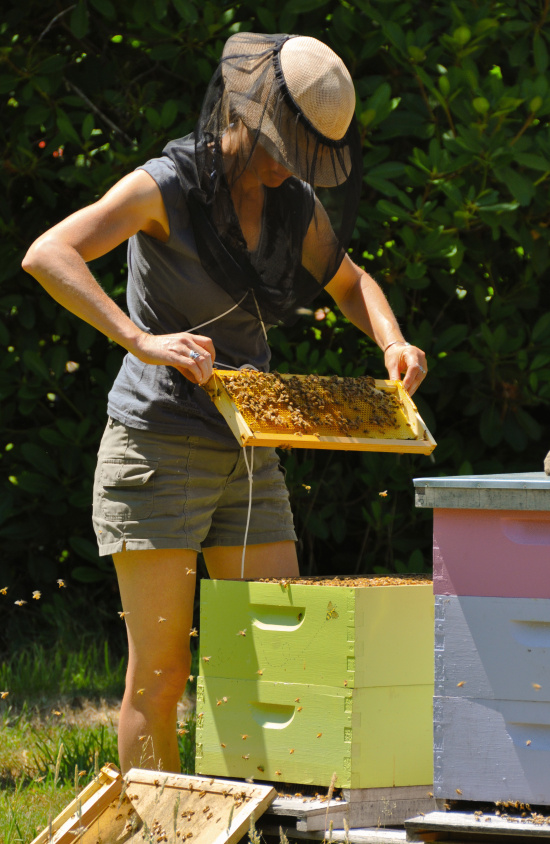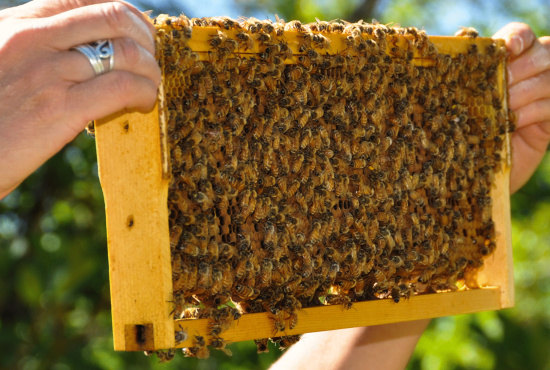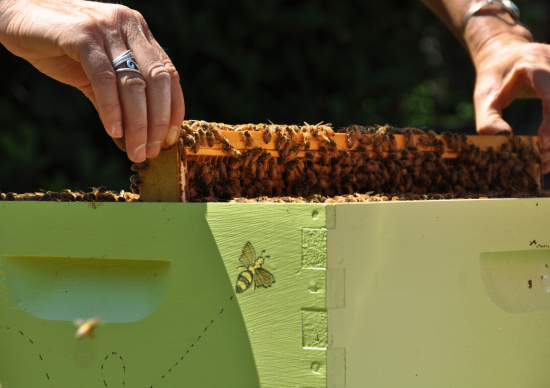The Sweet and Curious Nature of Beekeeping

“I love working with the bees,” Dana Bloomer confided. “They have a sweet and curious nature. Often they come and visit me when I am away from the hive and will hang out for a while.” With a name like Bloomer, it’s no wonder the bees find harmony in her presence.
Last summer, as I photographed her, she stood calmly in a hovering crowd of curious bees carefully dusting each vibrating frame of the hive with a brush of powdered sugar which she explained helped keep down mites.

Bloomer got into beekeeping when her husband began expressing interest in the creatures. “ One year for Christmas I got him all the gear and then that spring when I saw a class being offered through HSU, I was the one to sign up. I was nervous about the idea of working with the bees but it also sounded mysterious and intriguing. We have an orchard and a veggie garden so we wondered if our productivity would increase if we had bees. The thought of having our own source of honey was a big draw, too.”
She explained that the amount of work with natural beekeeping varies depending on the time of year.
In the fall, the main focus is to make sure that they will have enough honey to feed off of until the flowers begin to bloom again in the spring. During the winter, when it’s usually cold and stormy, you hardly do anything. The most critical time for honey bees is in late winter and early spring when they may have consumed all of their honey stores. When the weather allows, I look inside the hive to see if they need to be fed sugar syrup to make it through the season. One may need to feed a hungry colony every week to pull them through. In the spring time, I inspect the hive every week. This is the time when they are building up their population and storing as much honey and pollen as they can. During the summer, I usually do a full inspection every 1-2 weeks. At this time, the nectar flow has reached it’s peak and the bee’s reflect this in their population growth. In the summer, I inspect frequently to see if the colony is making plans to swarm. By late summer, the colony’s numbers begin to diminish. In the fall, I continue my inspections but less frequently.
The time involved isn’t onerous. “During the busiest time of the year,” she said, “some weeks I spend 30 minutes per hive doing a full inspection and other weeks I just peek in and it only takes a few minutes.”
According to Bloomer, beekeeping isn’t that expensive either. “ It costs about $100 for a colony of bees, another $75 for a smoker, a veil and a hive tool and about $100 for a basic hive set up. As the season goes on, one needs to add additional boxes to accommodate for the growth of the colony and for the nectar they are storing.”

Nectar and pollen are both collected by the bees. Nectar, as Bloomer described it, is a sweet liquid produced by flowers which is gathered by the bees and turned into honey. Pollen, though, provides protein for the bees. Both substances are eaten to provide nourishment. “Bees,” she went on to describe, “also forage for propolis (a sticky resin) that they get from trees, they use this to fill cracks and to sterilize the hive.”
Bees fly from their hive two to three miles in search of their food on a regular basis but, says Bloomer, “I have heard that they will travel up to 7 miles if they have to.”
Isn’t she afraid of the bees? No. She has been stung, of course. But mostly she blames herself rather than the bees.
Well, I got stung 3 times catching a swarm last spring…. Besides that I’ve been stung a few other times but it’s always seems to be my fault. Either I accidentally press my finger against one during an inspection or I am in the hive when it is too windy or cold. Sometimes when I am in a hurry they can sense it. When they are feeling protective of themselves, I have to pay attention and honor that or I am going to get stung. They usually give me a warning by coming at me with a kind of a bluff.
I did get stung in my eyelid one cold winter day when I peeked under the lid without a veil. There was no warning, just a strong hit in my eye lid, my husband had to pull the stinger out with pliers because that was all we had in the moment.
I’ll never do that again.
To Bloomer, the beauty of eating honey that “was collected from the native plants in my watershed and also from the plants and trees that my neighbors have planted and are tending” was one of the reasons she began keeping bees. But this last fall was her first harvest. “[M]y daughter and I extracted three quarts from one hive.”
But more than the food she collects is the connection she makes with her senses and with the earth. The words she uses when talking about the bees offers textures and emotions not flavors and smells. For example, she describes the harvest she got last fall as “…very sticky and exciting.”
Her smile and her movements were peaceful last summer as she moved like a Tai Chi master slowly through a golden circle of bees. The bees, it seems, provide sustenance for more than her body. They provide sustenance for her soul.
If you are interested in learning about beekeeping, Humboldt State University is offering classes both in Southern Humboldt and at HSU itself. Follow the link to find classes and times.


Join the discussion! For rules visit: https://kymkemp.com/commenting-rules
Comments system how-to: https://wpdiscuz.com/community/postid/10599/